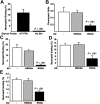Molecular mimicry of host sialylated glycans allows a bacterial pathogen to engage neutrophil Siglec-9 and dampen the innate immune response
- PMID: 19196661
- PMCID: PMC2665898
- DOI: 10.1182/blood-2008-11-187302
Molecular mimicry of host sialylated glycans allows a bacterial pathogen to engage neutrophil Siglec-9 and dampen the innate immune response
Abstract
Human neutrophil Siglec-9 is a lectin that recognizes sialic acids (Sias) via an amino-terminal V-set Ig domain and possesses tyrosine-based inhibitory motifs in its cytoplasmic tail. We hypothesized that Siglec-9 recognizes host Sias as "self," including in cis interactions with Sias on the neutrophil's own surface, thereby dampening unwanted neutrophil reactivity. Here we show that neutrophils presented with immobilized multimerized Siaalpha2-3Galbeta1-4GlcNAc units engage them in trans via Siglec-9. The sialylated capsular polysaccharide of group B Streptococcus (GBS) also presents terminal Siaalpha2-3Galbeta1-4GlcNAc units, and similarly engages neutrophil Siglec-9, dampening neutrophil responses in a Sia- and Siglec-9-dependent manner. Reduction in the neutrophil oxidative burst, diminished formation of neutrophil extracellular DNA traps, and increased bacterial survival are also facilitated by GBS sialylated capsular polysaccharide interactions with Siglec-9. Thus, GBS can impair neutrophil defense functions by coopting a host inhibitory receptor via sialoglycan molecular mimicry, a novel mechanism of bacterial immune evasion.
Figures


Similar articles
-
Host and pathogen hyaluronan signal through human siglec-9 to suppress neutrophil activation.J Mol Med (Berl). 2016 Feb;94(2):219-33. doi: 10.1007/s00109-015-1341-8. Epub 2015 Sep 28. J Mol Med (Berl). 2016. PMID: 26411873 Free PMC article.
-
Discovery and expression of 3 siglecs-like in Oreochromis niloticus neutrophil, and their interaction with group B streptococcal sialylated capsular polysaccharides.Mol Immunol. 2016 May;73:158-69. doi: 10.1016/j.molimm.2016.01.005. Epub 2016 Feb 1. Mol Immunol. 2016. PMID: 26847490
-
Sialoglycoproteins adsorbed by Pseudomonas aeruginosa facilitate their survival by impeding neutrophil extracellular trap through siglec-9.J Leukoc Biol. 2012 Apr;91(4):641-55. doi: 10.1189/jlb.0511260. Epub 2012 Jan 11. J Leukoc Biol. 2012. PMID: 22241833
-
Evolution of CD33-related siglecs: regulating host immune functions and escaping pathogen exploitation?Immunology. 2011 Jan;132(1):18-26. doi: 10.1111/j.1365-2567.2010.03368.x. Epub 2010 Nov 11. Immunology. 2011. PMID: 21070233 Free PMC article. Review.
-
Sialic acids siglec interaction: a unique strategy to circumvent innate immune response by pathogens.Indian J Med Res. 2013 Nov;138(5):648-62. Indian J Med Res. 2013. PMID: 24434319 Free PMC article. Review.
Cited by
-
Group B Streptococcus and Streptococcus suis capsular polysaccharides induce chemokine production by dendritic cells via Toll-like receptor 2- and MyD88-dependent and -independent pathways.Infect Immun. 2013 Sep;81(9):3106-18. doi: 10.1128/IAI.00113-13. Epub 2013 Jun 17. Infect Immun. 2013. PMID: 23774593 Free PMC article.
-
Alpha-Gal and Cross-Reactive Carbohydrate Determinants in the N-Glycans of Salivary Glands in the Lone Star Tick, Amblyomma americanum.Vaccines (Basel). 2020 Jan 9;8(1):18. doi: 10.3390/vaccines8010018. Vaccines (Basel). 2020. PMID: 31936588 Free PMC article.
-
Construction of a Lectin-Glycan Interaction Network from Enterohemorrhagic Escherichia coli Strains by Multi-omics Analysis.Int J Mol Sci. 2020 Apr 12;21(8):2681. doi: 10.3390/ijms21082681. Int J Mol Sci. 2020. PMID: 32290560 Free PMC article.
-
Decreased Siglec-9 Expression on Natural Killer Cell Subset Associated With Persistent HBV Replication.Front Immunol. 2018 May 30;9:1124. doi: 10.3389/fimmu.2018.01124. eCollection 2018. Front Immunol. 2018. PMID: 29899741 Free PMC article.
-
Hypersialylation in Cancer: Modulation of Inflammation and Therapeutic Opportunities.Cancers (Basel). 2018 Jun 18;10(6):207. doi: 10.3390/cancers10060207. Cancers (Basel). 2018. PMID: 29912148 Free PMC article. Review.
References
-
- Severi E, Hood DW, Thomas GH. Sialic acid utilization by bacterial pathogens. Microbiology. 2007;153:2817–2822. - PubMed
-
- Varki A, Angata T. Siglecs: the major subfamily of I-type lectins. Glycobiology. 2006;16:1R–27R. - PubMed
-
- Crocker PR, Paulson JC, Varki A. Siglecs and their roles in the immune system. Nat Rev Immunol. 2007;7:255–266. - PubMed
-
- Paul SP, Taylor LS, Stansbury EK, McVicar DW. Myeloid specific human CD33 is an inhibitory receptor with differential ITIM function in recruiting the phosphatases SHP-1 and SHP-2. Blood. 2000;96:483–490. - PubMed
Publication types
MeSH terms
Substances
Grants and funding
LinkOut - more resources
Full Text Sources
Other Literature Sources
Research Materials

